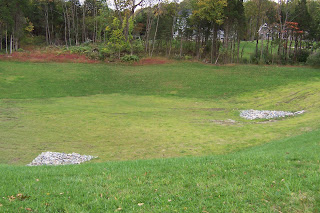Landscapes Made of Ticky-Tacky


Little boxes on the hillside,
Little boxes made of ticky tacky,
Little boxes on the hillside,
Little boxes all the same.
There's a green one and a pink one
And a blue one and a yellow one,
And they're all made out of ticky tacky
And they all look just the same.
Malvina Reynolds wrote it, Pete Seeger sang it, and for the past several weeks, I’ve been having to look at it as I drive by a housing development where the foundation plantings all look just the same. There’s a red one, and a yellow one, and a green one, and a gold one, and they’re all made of invasive Japanese barberry, and they all look just the same.
There are no fewer than a half-dozen of these homes with the same landscaping, side by side, visible from the road. The primary difference between them is the color of the dyed mulch. One could argue whether the cultured stone on the façade of these houses should be considered a “natural” look. However the largest portion of each of the lots is in conservation easement, so the back yards are forested, with large rock outcrops. Wrong plants in the wrong place. Ugly. Hmmmmn. As chair of the Environmental Commission, I guess I still have more work to do.
This is the perfect example of too much of a good thing. Folks around here like Japanese barberry because the deer don’t. But the birds spread the seed far and wide, to the point where we now have wine-colored ones popping up in the woods. Give the chartreuse variety a few more years and I’m sure we’ll be seeing that as well.
Good alternatives are native Bayberry, Beautyberry, and Blueberry, as well as the non-invasive Cotoneasters (watch out for Frenchet and Silverleaf).

